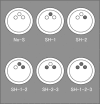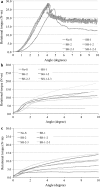Initial stability of cementless acetabular cups: press-fit and screw fixation interaction--an in vitro biomechanical study
- PMID: 25421640
- PMCID: PMC4363363
- DOI: 10.1007/s00590-014-1571-4
Initial stability of cementless acetabular cups: press-fit and screw fixation interaction--an in vitro biomechanical study
Abstract
Background: Press-fit and screw fixation are important technical factors to achieve initial stability of a cementless acetabular cup for good clinical results of total hip arthroplasty. However, how these factors affect one another in initial cup fixation remains unclear. Therefore, this study aimed to evaluate the mutual influence between press-fit and screw fixation on initial cup stability.
Methods: Foam bone was subjected to exact hemispherical-shape machining to diameters of 48, 48.5 and 49 mm. A compressive force was applied to ensure seating of a 48-mm-diameter acetabular cup in the foam bone prior to testing. Screws were inserted in six different conditions and tightened in a radial direction at the same torque strength. Then, the socket was rotated with a twist-testing machine, and the torque value at the start of axial rotation between the socket and the foam bone was measured under each screw condition.
Results: The torque values for the 48-mm-diameter reaming were >20 N m higher than those for the 48.5- and 49-mm-diameter reaming in each screw condition, indicating that press-fit fixation is stronger than screw fixation. Meanwhile, torque values for the 48.5- and 49-mm-diameter reaming tended to increase with increasing the number of screws.
Conclusions: According to our experiment, press-fit fixation of a cementless acetabular cup achieved rigid stability. Although the supplemental screws increased stability of the implant under good press-fit conditions, they showed little impact on whole-cup stability. In the case of insufficient press-fit fixation, cup stability depends on screw stability and increasing the number of additional screws increases cup stability.
Figures





Similar articles
-
[Cementless socket fixation based on the "press-fit" concept in total hip joint arthroplasty].Acta Chir Orthop Traumatol Cech. 2002;69(1):8-15. Acta Chir Orthop Traumatol Cech. 2002. PMID: 11951572 German.
-
Effects of screw eccentricity on the initial stability of the acetabular cup.Int Orthop. 2007 Aug;31(4):451-5. doi: 10.1007/s00264-006-0226-4. Epub 2006 Sep 1. Int Orthop. 2007. PMID: 16947050 Free PMC article.
-
A novel method to assess primary stability of press-fit acetabular cups.Proc Inst Mech Eng H. 2014 Nov;228(11):1126-34. doi: 10.1177/0954411914557714. Epub 2014 Nov 9. Proc Inst Mech Eng H. 2014. PMID: 25384445
-
Are additional screws required for press-fit fixation of cementless acetabular cups? A systematic review and meta-analysis.J Orthop Traumatol. 2022 Feb 10;23(1):9. doi: 10.1186/s10195-022-00629-8. J Orthop Traumatol. 2022. PMID: 35142933 Free PMC article.
-
Factors That Influence Bone-Ingrowth Fixation of Press-Fit Acetabular Cups.JBJS Rev. 2019 Jun;7(6):e2. doi: 10.2106/JBJS.RVW.18.00147. JBJS Rev. 2019. PMID: 31166219 Review. No abstract available.
Cited by
-
Mid-term clinical outcomes of the uncemented Robert Mathys pressfit cup.World J Clin Cases. 2024 Jul 6;12(19):3684-3691. doi: 10.12998/wjcc.v12.i19.3684. World J Clin Cases. 2024. PMID: 38994294 Free PMC article.
-
Three-dimensional-printed custom-made hemipelvic endoprosthesis for primary malignancies involving acetabulum: the design solution and surgical techniques.J Orthop Surg Res. 2019 Nov 27;14(1):389. doi: 10.1186/s13018-019-1455-8. J Orthop Surg Res. 2019. PMID: 31775805 Free PMC article.
-
Relating total hip replacement and acetabular cup positioning with outcome: A systematic review.Bioinformation. 2025 Feb 28;21(2):145-154. doi: 10.6026/973206300210145. eCollection 2025. Bioinformation. 2025. PMID: 40322696 Free PMC article.
-
Deeper Central Reaming May Enhance Initial Acetabular Shell Fixation.Arthroplast Today. 2020 Jun 8;6(3):343-349. doi: 10.1016/j.artd.2020.03.012. eCollection 2020 Sep. Arthroplast Today. 2020. PMID: 32548228 Free PMC article.
-
No effect of additional screw fixation of a cementless, all-polyethylene press-fit socket on migration, wear, and clinical outcome.Acta Orthop. 2016 Aug;87(4):363-7. doi: 10.1080/17453674.2016.1190244. Epub 2016 Jun 14. Acta Orthop. 2016. PMID: 27299418 Free PMC article. Clinical Trial.
References
MeSH terms
LinkOut - more resources
Full Text Sources
Other Literature Sources

